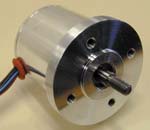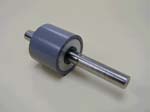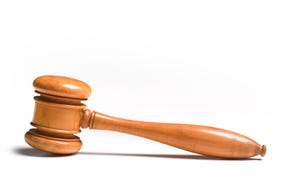Controlling Noise and Vibration in Brushless Motor—Driven Devices
Medical Device & Diagnostic Industry MagazineMDDI Article IndexOriginally Published September 2000 Exploring system- and motor-level design issues can help product developers minimize mechanical vibration and noise.Frank Leong
September 1, 2000
Medical Device & Diagnostic Industry Magazine
MDDI Article Index
Originally Published September 2000
Frank Leong
For virtually any motor-driven motion system, the control of mechanical vibration and noise is a critical design factor that can significantly impact the system's performance, reliability, cost, safety, and suitability for use. Uncontrolled physical vibrations can degrade the system's overall efficiency, accelerate material fatigue, and compound the natural rate of wear on friction surfaces. Similarly, in handheld devices, physical vibrations can be transmitted to the operator, resulting in safety problems and repetitive-stress injuries. Excessive vibrations in the auditory range can also raise safety issues and make devices totally unacceptable for use in quiet environments, such as in hospital rooms.
For many high-speed precision systems, the combination of brushless motor technologies and advanced high-grade bearing mechanisms has resulted in a significant reduction of physical vibration problems. Compared with a brush-type motor, an inner rotating, permanent-magnet-rotor brushless motor places all of the electrical windings on the surrounding stator structure rather than on the rotor itself. Consequently, the amount of rotating mass is significantly lower and can be designed with better symmetry, thereby mitigating much of the vibration generated within the motor itself. However, because of the delicate interrelationships between the motor and the surrounding system, excessive vibrations in the auditory range can present significant concerns even with brushless motor systems.
 Using machined parts rather than stampings in high-precision brushless motors reduces system vibration by helping achieve tighter internal tolerances.
Using machined parts rather than stampings in high-precision brushless motors reduces system vibration by helping achieve tighter internal tolerances.
This article explores both the system-level and motor-level design issues involved in minimizing vibration and noise in brushless motor–driven motion systems.
DESIGN CHALLENGES
Even the most simple motion systems involve critical interactions between the internal vibration properties of the motor and the external physical characteristics of the system being driven, such as load, mass, balance, harmonics, and damping—the natural tendency of the surrounding structure to absorb vibrational energy. System designers, working in conjunction with their motor suppliers, must concurrently address both the internal and external factors in order to remain within the overall specified "noise and vibration budgets" for their end products.
Brushless motors are currently relied upon to drive a wide variety of system-level applications, such as:
Fans for inducing directed air movement in everything from medical ventilators to computer systems.
Precision spinning of optical mirrors used in bar code readers.
Driving precision buffing and polishing systems, such as those used for semiconductor wafer burnishing.
Providing controlled high-speed acceleration in laboratory centrifuges.
Implementing high-speed dental drills.
Driving sparkless fluid pumps or handheld gas analyzers in controlled or flammable environments.
Servo controllers for fast-movement, light-load, precision industrial positioning systems.
In any of these applications, the presence of excessive vibration and noise can be problematic. For example, in respiratory blower systems, a poorly calibrated motor can transmit higher vibrations into the fan being driven, which can result in poor performance and unfavorable noise. Even the lowest-vibration brushless motor available will not be able to compensate for external design deficiencies—such as a fan that is unbalanced, too heavy, or fails to sufficiently match the motor's specifications. Likewise, inadequately designed cables, belts, or ball screws used in x-y positioning systems will affect the proper handling of the overall acceleration and deceleration requirements of the application, resulting in excessive vibration.
 Motor shafts must be straight to prevent incremental errors in motion systems.
Motor shafts must be straight to prevent incremental errors in motion systems.
MEASUREMENT METHODS
Assessment of noise must be conducted in a sound-insulated environment—where background noise is significantly less than product noise—using equipment capable of distinguishing noise in the 20–80-dB range. Testing criteria must explicitly define the acceptable decibel range and test conditions. It also may be a good idea to test across a number of different operating conditions.
Because the various components of any motion system are made of different materials, they often have considerably different coefficient of thermal expansion (CTE) characteristics, causing them to expand and contract at different rates as the internal or ambient temperatures change with operating conditions. These differences in CTE can cause minute changes in the tolerances between parts, resulting in significant changes in the amount of vibration.
In most instances, individual motor components are tested and certified to meet specified noise parameters. This is intended to provide the system designers with a reliable starting point from which to make their motor component selections. Ultimately, however, the complete motor and load assembly will need to be tested as an integrated unit to ensure achievement of noise objectives. Some manufacturers have turned to their motor suppliers to further carry out the assembly process. This simplifies the overall process and enables the system manufacturer to simply take receipt of a fully tested and certified assembly.
MATERIAL SELECTION AND DESIGN
One of the most critical factors in controlling vibration is minimizing the overall mass of the motor-and-load subsystem. For example, an examination of many medical, computer, and industrial fan assemblies available on the market reveals an evolution toward the use of plastic fans as a much lighter alternative to traditional metal fans. The inherently lower mass of plastic minimizes the amount of energy required to overcome the fan's natural inertia and therefore reduces the mechanical stresses within the fan assembly that can lead to excess vibration.
On the downside, because plastic fans are naturally less rigid than metal fans, they can show a greater tendency for deformation under acceleration and at higher speeds. Deformation can unbalance the fan assembly, leading to intermittent vibration problems within the specified operating ranges.
Tighter control over fan manufacture has also proved to be of great assistance in reducing vibration. Traditionally, it was often accepted that some fan assemblies had to be manually balanced by removing or adding material during a testing process that was conducted after attachment of the fan to the motor. Obviously, the requirement for such secondary operations could add significant cost and time to the assembly process while also decreasing overall production yields and increasing waste. By investing in more-stringent process control during the fan-molding process, forward-looking manufacturers have found that they can now consistently mix and match fans and motors that are mutually balanced within acceptable vibration limits.
CONSIDERATIONS FOR COUPLING AND DAMPING EFFECTS
Another system-level factor that can inject unwanted vibration is the use of intervening couplers to transmit the energy between the motor and the load. An opportunity for a loss of power and an increase in the cumulative system-level vibration rises at every point that energy is transferred between two components. In complex x-y positioning systems, the use of some coupling mechanisms often cannot be avoided. However, for many specialized rotary motion implementations, the use of innovative modifications, such as longer motor shafts and custom mounting arrangements, can allow the system designer to maintain direct drive without intervening couplers or counterbalances.
In evaluating their overall system-level vibration budgets, system designers also need to take into account the effects of damping actions, both within the motor and throughout the system. When an exciting force is equal or close to one of the natural frequencies of the structure, the amplitude of vibration is influenced by the damping capacity of the structure. This effectively converts the vibration energy into heat.
EXTERNAL VERSUS INTERNAL MOTOR BALANCING
Some system designers have come to believe that motor vibration can be compensated for by attaching an external counterbalance to the shaft that extends from the back of the motor. For today's high-precision applications, this type of external balancing methods cannot adequately overcome unacceptable internal motor vibrations. Worse yet, the additional load from the counterweight can actually diminish the torque performance of the motor and place undue stress on the motor parts and bearings. Consequently, most leading motor manufacturers have found that the preferable way to reduce total vibration is to work on the motor itself.
For midrange speed applications, such as a polishing system that is running at 3000–4000 rpm, precision internal motor balancing and calibration is the only practical method for eliminating unacceptable vibration. Achievement of this goal depends critically upon the manufacturing and process control methods used for the motor. If every motor component isn't adequately controlled from the first step, the overall quality of the motor is compromised and cannot be "added on" in a subsequent process. For example, a shaft that is not perfectly straight will add incremental error factors that can accumulate to result in an adverse effect. For high-precision brushless motors, the use of machined parts rather than stampings can help achieve tighter internal dimensional tolerances.
Another key factor in optimizing internal balance for a brushless motor is the use of specialized magnetic materials in the rotor to achieve higher energy densities within a smaller form factor (see sidebar "Using Supermagnet Rotor Materials" below).
USING SUPERMAGNET ROTOR MATERIALS To meet the demands of medical device manufacturers and other advanced technology customers, motor suppliers investigated the use of specialized magnets, such as neodymium iron boron, for designing brushless motors with inherently smaller rotor assemblies to provide optimal internal balance and minimal vibration. Neodymium iron boron inherently offers very high energy density characteristics, which enable much better performance in a smaller magnet than can be achieved with conventional alnico (aluminum nickel cobalt) or ferrite magnets. Because motor designers can use a smaller amount of neodymium material to obtain the required magnet performance, the diameter of the rotor can be minimized with a commensurate reduction in inertia, imbalance, and the risk of vibration. As an additional benefit, neodymium does not demagnetize over time like other magnet materials, thereby providing more consistent performance over a long period of time. For high-temperature applications, samarium cobalt is another good alternative material that combines high energy density and exceptional thermal characteristics. |
Bearings are also important for achieving a high-precision motor design that can provide consistent low-vibration performance over an extended period. In a brush-type motor, the brushes are generally the limiting factor in mean time between failures, with a typical life ranging from 500 to several thousand hours. In contrast, if the bearings are adequately designed, a brushless motor can last between 5000 and 30,000 hours. Low-grade brushless motors invariably fail due to the effects of vibrational wear on poor-quality bearings and a failure to appropriately balance the load on the bearings.
Bearing wear is essentially a function of the frequency of vibration, as determined by the speed of rotation, the continuous load on the bearings, and the intensity of vibration, as influenced by the balance of the load. Overall system requirements dictate the frequency at which loading and unloading occurs, but it is within the motor designer's ability to help mitigate the intensity of loading. Proper attention to bearing design and use of high-quality ball bearings can reduce the intensity of load on the bearings by a factor of 100 or more, thereby optimizing performance level and significantly extending system life.
CONCURRENT ENGINEERING BENEFITS
Because the motor and the driven load must function together smoothly as a single unit with minimal noise and vibration, the system designer and motor supplier must work closely together to achieve optimal results. For high-precision applications, this often requires going well beyond simply ordering motor components based on a printed specification. Establishment of a close collaborative concurrent engineering relationship early in the development process can pay significant dividends by avoiding unnecessary design modifications. Collaborative engineering methods based upon a shared understanding of the application objectives can also be used to quickly resolve design or performance problems as they arise (see sidebar "Design Collaboration for Optimal Bearing Life," below).
DESIGN COLLABORATION FOR OPTIMAL BEARING LIFE In a specific case, a system's motor appeared to exhibit a relatively low level of discernible vibration and the load characteristics were fairly balanced. However, the motor was required to operate at a speed of 20,000 rpm and life tests showed its bearings were failing prematurely between 6 and 20 hours. Through empirical testing it was determined that although the load seemed to be balanced, a slight eccentricity between the load and the motor shaft was putting an excessive load on the bearings. The intensity of the vibration was therefore wearing down the bearings rapidly. By working closely with the customer, the motor supplier's engineers redesigned the motor with a different type of bearing to reduce load intensity. As a result, the measurable bearing life was increased by a factor of 1000 while still achieving the application's overall performance goals. |
Concurrent engineering also assists the system designer with trade-offs between the overall cost and the performance goals because it enables the motor supplier to understand the level of thoroughness that is actually required for internal balancing of the motor. Depending upon the requirements of the real-world application— e.g., patient-care monitors or laboratory equipment—a motor manufacturer could need to spend anywhere from a few seconds to a half hour in the motor-balancing process, with the cost ultimately being passed on to the customer. By working together, innovative solutions can be found to target manufacturing techniques and level of effort to the specific requirements of the end system. In a recent development effort for a medical application, the customer needed a stringent combination of low vibration and low-cost manufacturing. By incorporating a proprietary technique, the motor supplier's engineers were able to develop a fast 5-second balancing process that met both performance and budgetary requirements.
CONCLUSION
The control of vibration in brushless motor motion systems needs to address the entire spectrum from the internal balancing of the motor itself to the integrity of the bearings to the overall design and balance of the load being driven. The bottom line is that you can have the best motor in the world but a faulty design will render it useless. On the other hand, for today's most demanding and vibration-sensitive motion system designs, it is imperative that the overall implementation be built around brushless motor technologies that provide a solid ultra-low-vibration foundation.
Frank Leong is systems applications engineer at BEI Sensors and Systems Co., Kimco Magnetics Div. (San Marcos, CA).
Back to the MDDI September table of contents | Back to the MDDI home page
Copyright ©2000 Medical Device & Diagnostic Industry
You May Also Like
.png?width=300&auto=webp&quality=80&disable=upscale)

